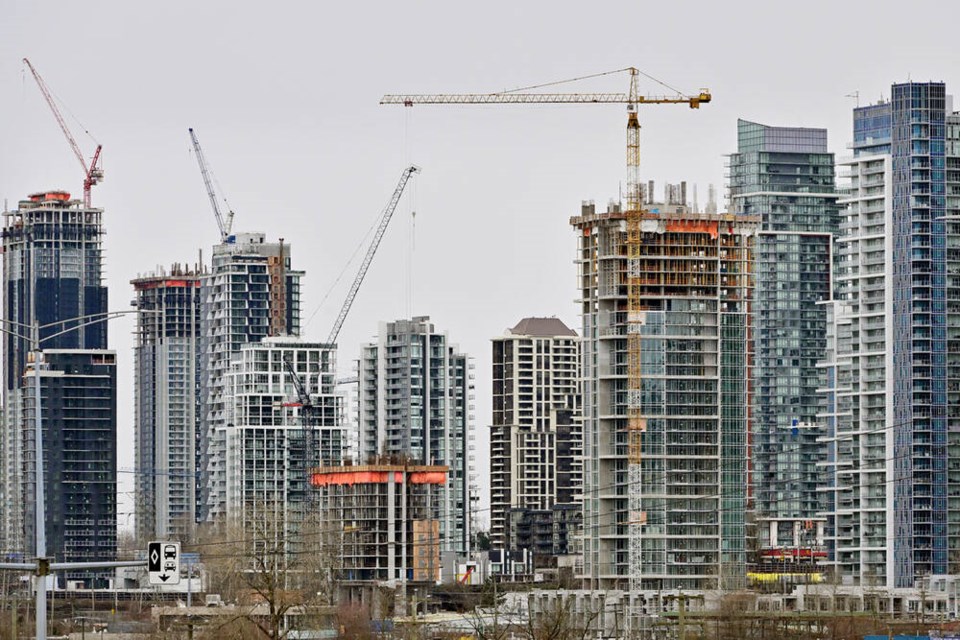Burnaby councillors roundly rejected a slew of staff recommendations that would have allowed developers to build even more condos in return for building required non-market rental housing.
The recommendations were part of a review of Burnaby’s rental use zoning policy, which requires developers of multifamily buildings to include 20 per cent non-market rental units.
“It seems to me that we’re just gifting (developers) more free density for them to build more condos,” said Coun. Pietro Calendino at a development committee meeting this week. “And that was not the intent of the referral to staff to come back with a review.”
Coun. Alison Gu agreed and called the recommended calculations for how much housing could be built “confusing.” She described it as a jumble of coloured Lego blocks scattered on a table where “you can pick and choose and make it your own adventure.”
“I think from a public perspective, from council’s perspective – anyone who’s not a planner, it’s difficult to wrap your head around what these numbers actually translate into,” Gu said.
The policy currently requires developers to build 20 per cent below-market rental units, which is calculated on a certain number of units initially allowed on a site, or “base density.” To make up for the cost of building those rentals, Burnaby allows developers to build extra condos on the site, called “offset density.”
The policy review included financial analysis by third-party land-use economist firm Coriolis Consulting, which supported the idea of increasing the amount of offset density and, therefore, increasing the number of condos developers can build on a site to subsidize cost of building the required non-market rentals.
The Coriolis report said if the policy were adjusted to reduce the number of condos in exchange for the cost of building rentals, or to require more non-market rentals, or to build even more affordable rentals, developers would be less likely to build in Burnaby.
The councillors on the committee unanimously disapproved of the report’s findings and suggested the equations proposed by staff were too confusing.
“I really think that we should try to keep it simple, as much as possible,” Coun. Alison Gu said.
“We need the public onboard to understand that these buildings are generating affordable rentals. We need it to be transparent.”
Rental requirement an issue for developers
Staff said some developers are struggling to meet the required 20 per cent rental requirement.
Ed Kozak, general manager of planning and development, said certain “well-advanced” projects in the planning stage are “precarious in terms of viability,” due to the cost of providing the non-market rental housing.
But Coun. Sav Dhaliwal noted the city did “reasonably well” in recent years when it came to development applications, and asked if Burnaby were “in peril” compared to neighbouring municipalities.
“I’d like to see more evidentiary proof on this one … This is a natural thing for a developer to ask. I don’t think anybody was doing cartwheels when we introduced inclusionary (rental) zoning,” Dhaliwal said.
“My point is, do not offer any more density for condos, period. … It’s not about how many condos are being built. There’s a lot of condos being built, but lots of condos are not affordable. … When we said we’re going to have a review: how are we going to meet our targets of housing? Not see their (developer) obligations met.”
Direction change: Tower fatigue
A number of councillors said rental units should be built in neighbourhoods outside the four town centres.
“Town centres are sucking up everything else where we could be doing other things, and maybe that’s what we should be doing: providing more affordability to homes being built outside town centres. Town centres seem to be doing well. That’s why I think we’ve got to go back to square 1 on this,” Dhaliwal said.
He added “the time has come” to better support smaller developers to build more wood-frame rental homes.
Calendino said residents have “a bit of fatigue” regarding building heights in the town centres.
“I personally would like to see more spread-out development,” Calendino said.
While the urban villages are an example of that, he suggested, it could also include major roads, near transit, like Canada Way or Boundary Road.
“That’s where we can go with the stick frame of a four-to-six storey building to accommodate more affordable housing – and yet, we are lowering the density for those type of projects,” Calendino said.
Kozak said that was unrelated to the rental use policy under review, which deals with the inclusionary non-market rental requirements in town centres and urban villages, and was instead an official community plan issue.
But Calendino and Gu pushed back.
“To be quite honest, I’m a bit disappointed in terms of the breadth of this report,” Gu said. “Because we’ve been waiting for, I don’t know how much time, but there was a motion passed last year at council to direct staff to look at how to increase the amount of affordable purpose-built rentals that are missing … I don’t think that … I see that reflected.”
“Obviously, we’re not happy with the recommendations in the report,” said Calendino.
The report was unanimously rejected by the committee and turned back to staff for revisions.





